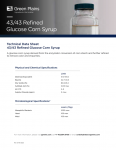Not all indulgent snacks contribute equally to obesity and not all strategies to reduce their consumption are effective

“Stratospheric obesity rates in the United States are driving policies that target high-calories, high sugar foods and beverages,” but “all indulgent and ‘junk foods’ are not created equal, and therefore, should not be lumped together for policy-decision purposes,” researchers at Georgetown and Tufts University argue in a report published last week by the Business for Impact at Georgetown University’s McDonough School of Business and made possible with funding from the National Confectioners Association.
As such, they argue, a one-size fits all approach to discouraging consumption of junk food, such as by taxing at a higher-rate products with a certain percentage of sugar, sodium or saturated fat or requiring them to bare stop sign labelling or even outright banning their sale will not help lower obesity rates.
They add a more effective approach is to target the unhealthy products most often purchased or consumed disproportionately by those with obesity – which, according to the research, means soda, sweet baked goods, and savory snacks – not, as previously believed, chocolate and candy.
By examining not just the effect of individual product categories on consumption but also the amount of sugar and calories consumed by category, the frequency and amount of the products consumed by different shoppers and the connection of categories to consumers with obesity they found there was no statistically significant differences in purchases of chocolate and non-chocolate candy between consumers with a healthy weight and those who are obese.
However, purchases of regular soda, packaged pastries and baked goods, cookies, chips and pretzels and ice cream all were purchased 13.4% to 39.2% more often by consumers who were obese than those who were healthy.
Are beverages, sweet baked goods the biggest culprits contributing to obesity?
This finding is reinforced by the National Health and Nutrition Examination Survey )NHANES) data, which found beverages and sweet baked goods contributed the most calories of all measured indulgent products at 7.9% and 6.6% respectively, followed by savory snacks at 3.8%
Candy, including chocolate, contributed only 1.9% of calories to the diets of Americans older than 2 years between 2017 and 2018.
Likewise, the NHANES data showed the primary source of added sugar comes from beverages at 41.4%, followed by sweet baked goods at 14.4% with candy, farther down the list at 6.6%.
Finally, the per capita consumption of sweet baked goods far outweighed that of candy at a whopping 40 pounds per person per year compared to 9.4 pounds for chocolate and 6.7 pounds for sugar confectionary, according to data published by Euromonitor in 2020.
“The bottom line is not all [indulgent products] are created the same and we have to be looking across different products to really come up with a smart strategy or policy” that considers that contribution of individual product categories to obesity and excess consumption, said Hank Cardello, one of the researchers and the executive director of the Leadership Solutions of Health + Prosperity program at Georgetown University’s Business for Impact and chair of the Portion Balance Coalition.
[Editor’s note: Want to better understand how consumers think about snacking? Join FoodNavigator-USA Sept. 27 for a free webinar on healthy snack trends. Get all the details and register HERE.]
Portion control could help brands fend off bad reputation
As soda, sweet baked goods and savory snacks are thrust into the hot seat, Cardello urged industry leaders in this space to follow the lead of some in the chocolate and confections industry to proactively limit sizes and reformulate products with less sugar and fewer calories.
Doing so, he said, could help them curry favor with policymakers and elevate their reputation and appeal to consumers as they could shift under the better-for-you health halo that increasingly influences consumer purchases.
According to the report, 47% of consumers surveyed by Natural Marketing Institute said they were eating healthier food options, while consulting firm Accenture reported that 59% expected to shop for more health-conscious products coming out of the pandemic.
And yet, NMI notes, 40% of consumers are still looking for comfort from junk foods.
To help consumers balance these conflicting priorities, Cardello recommend companies offer smaller portions – a strategy embraced by the National Confectioners Association through its Always A Treat initiative, in which participating companies ensure calorie information is on the front of 90% of its packaging and that at least half of the single serve products are 200 calories or less.
Energy density
While portion control is a good starting point, it is not a panacea, argued Bill Dietz of the Milken Institute School of Public Health, who participated in a moderated conversation with Cardello and a representative from Mars Wrigley.
He explained that satiety is not regulated by calories, but rather volume, and so food and beverage companies must explore how they can reduce the caloric density of a product without sacrificing the properties that consumers want from it.
“One of the strategies … is to increase the water content, which also increases the risk of spoilage, but that is an area that, I think, is ripe for development,” he said.
Other strategies that he said could help reduce obesity and position companies in the good graces of consumers and policy makers is to reduce advertising directed to children and work with food service providers to reduce calories in the products and portions they serve.





















